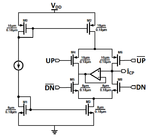firasgany7
Junior Member level 1
Im trying to understand the the benefits of Charge Pump with unity gain amplifier compared to the normal charge pump that is implemented using two current mirrors:

we have few questions about this circuit:
1) how does the unity gain amplifier helps me get higher input impedance in order to have more constant current? (this is called bootstrapping circuit)
2) how does keeping the same VDS for M4 and M6 the same through the amplifier with feedback helps solve the current mismatch problem?
3) Why is this circuit is more suitable to work with Low Swing inputs?
I attached some references that deal with this design if they can help you get better picture.

we have few questions about this circuit:
1) how does the unity gain amplifier helps me get higher input impedance in order to have more constant current? (this is called bootstrapping circuit)
2) how does keeping the same VDS for M4 and M6 the same through the amplifier with feedback helps solve the current mismatch problem?
3) Why is this circuit is more suitable to work with Low Swing inputs?
I attached some references that deal with this design if they can help you get better picture.